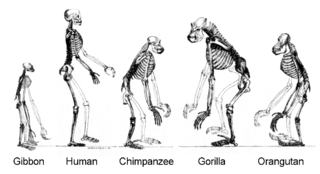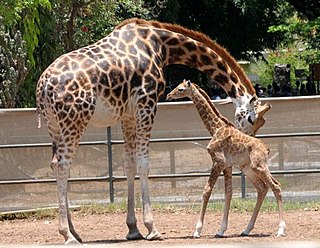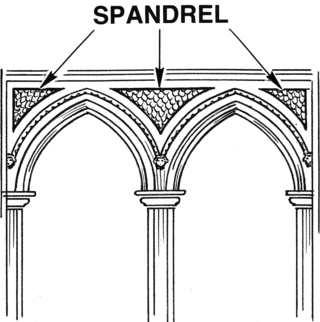Related Research Articles

Human evolution is the evolutionary process within the history of primates that led to the emergence of Homo sapiens as a distinct species of the hominid family that includes all the great apes. This process involved the gradual development of traits such as human bipedalism, dexterity, and complex language, as well as interbreeding with other hominins, indicating that human evolution was not linear but weblike. The study of the origins of humans involves several scientific disciplines, including physical and evolutionary anthropology, paleontology, and genetics; the field is also known by the terms anthropogeny, anthropogenesis, and anthropogony.

Homininae, is a subfamily of the family Hominidae (hominids). This subfamily includes two tribes, Hominini and Gorillini, both having extant species as well as extinct species.

Dollo's law of irreversibility, proposed in 1893 by Belgian paleontologist Louis Dollo states that, "an organism never returns exactly to a former state, even if it finds itself placed in conditions of existence identical to those in which it has previously lived ... it always keeps some trace of the intermediate stages through which it has passed."
Encephalization quotient (EQ), encephalization level (EL), or just encephalization is a relative brain size measure that is defined as the ratio between observed and predicted brain mass for an animal of a given size, based on nonlinear regression on a range of reference species. It has been used as a proxy for intelligence and thus as a possible way of comparing the intelligence levels of different species. For this purpose, it is a more refined measurement than the raw brain-to-body mass ratio, as it takes into account allometric effects. Expressed as a formula, the relationship has been developed for mammals and may not yield relevant results when applied outside this group.

In evolutionary developmental biology, heterochrony is any genetically controlled difference in the timing, rate, or duration of a developmental process in an organism compared to its ancestors or other organisms. This leads to changes in the size, shape, characteristics and even presence of certain organs and features. It is contrasted with heterotopy, a change in spatial positioning of some process in the embryo, which can also create morphological innovation. Heterochrony can be divided into intraspecific heterochrony, variation within a species, and interspecific heterochrony, phylogenetic variation, i.e. variation of a descendant species with respect to an ancestral species.
Evolutionary neuroscience is the scientific study of the evolution of nervous systems. Evolutionary neuroscientists investigate the evolution and natural history of nervous system structure, functions and emergent properties. The field draws on concepts and findings from both neuroscience and evolutionary biology. Historically, most empirical work has been in the area of comparative neuroanatomy, and modern studies often make use of phylogenetic comparative methods. Selective breeding and experimental evolution approaches are also being used more frequently.
The evolution of human intelligence is closely tied to the evolution of the human brain and to the origin of language. The timeline of human evolution spans approximately seven million years, from the separation of the genus Pan until the emergence of behavioral modernity by 50,000 years ago. The first three million years of this timeline concern Sahelanthropus, the following two million concern Australopithecus and the final two million span the history of the genus Homo in the Paleolithic era.
Cognitive specialization suggests that certain behaviors, often in the domain of social communication, are passed on to offspring and refined to be maximally beneficial by the process of natural selection. Specializations serve an adaptive purpose for an organism by allowing the organism to be better suited for its habitat. Over time, specializations often become essential to the species' continued survival. Cognitive specialization in humans has been thought to underlie the acquisition, development, and evolution of language, theory of mind, and specific social skills such as trust and reciprocity. These specializations are considered to be critical to the survival of the species, even though there are successful individuals who lack certain specializations, including those diagnosed with autism spectrum disorder or who lack language abilities. Cognitive specialization is also believed to underlie adaptive behaviors such as self-awareness, navigation, and problem solving skills in several animal species such as chimpanzees and bottlenose dolphins.
Evolutionary developmental psychology (EDP) is a research paradigm that applies the basic principles of evolution by natural selection, to understand the development of human behavior and cognition. It involves the study of both the genetic and environmental mechanisms that underlie the development of social and cognitive competencies, as well as the epigenetic processes that adapt these competencies to local conditions.
Mosaic evolution is the concept, mainly from palaeontology, that evolutionary change takes place in some body parts or systems without simultaneous changes in other parts. Another definition is the "evolution of characters at various rates both within and between species".408 Its place in evolutionary theory comes under long-term trends or macroevolution.

In evolutionary biology, a spandrel is a phenotypic trait that is a byproduct of the evolution of some other characteristic, rather than a direct product of adaptive selection. Stephen Jay Gould and Richard Lewontin brought the term into biology in their 1979 paper "The Spandrels of San Marco and the Panglossian Paradigm: A Critique of the Adaptationist Programme". Adaptationism is a point of view that sees most organismal traits as adaptive products of natural selection. Gould and Lewontin sought to temper what they saw as adaptationist bias by promoting a more structuralist view of evolution.

Ontogeny and Phylogeny is a 1977 book on evolution by Stephen Jay Gould, in which the author explores the relationship between embryonic development (ontogeny) and biological evolution (phylogeny). Unlike his many popular books of essays, it was a technical book, and over the following decades it was influential in stimulating research into heterochrony, which had been neglected since Ernst Haeckel's theory that ontogeny recapitulates phylogeny had been largely discredited. This helped to create the field of evolutionary developmental biology.

The evolution of the brain refers to the progressive development and complexity of neural structures over millions of years, resulting in the diverse range of brain sizes and functions observed across different species today, particularly in vertebrates.

Homo erectus is an extinct species of archaic human from the Pleistocene, with its earliest occurrence about 2 million years ago. Its specimens are among the first recognizable members of the genus Homo.

Gerd B. Müller is an Austrian biologist who is emeritus professor at the University of Vienna where he was the head of the Department of Theoretical Biology in the Center for Organismal Systems Biology. His research interests focus on vertebrate limb development, evolutionary novelties, evo-devo theory, and the Extended Evolutionary Synthesis. He is also concerned with the development of 3D based imaging tools in developmental biology.

In brain anatomy, the lunate sulcus or simian sulcus, also known as the sulcus lunatus, is a fissure in the occipital lobe variably found in humans and more often larger when present in apes and monkeys. The lunate sulcus marks the transition between V1 and V2.
Cognitive genomics is the sub-field of genomics pertaining to cognitive function in which the genes and non-coding sequences of an organism's genome related to the health and activity of the brain are studied. By applying comparative genomics, the genomes of multiple species are compared in order to identify genetic and phenotypical differences between species. Observed phenotypical characteristics related to the neurological function include behavior, personality, neuroanatomy, and neuropathology. The theory behind cognitive genomics is based on elements of genetics, evolutionary biology, molecular biology, cognitive psychology, behavioral psychology, and neurophysiology.
Evolutionary psychology of language is the study of the evolutionary history of language as a psychological faculty within the discipline of evolutionary psychology. It makes the assumption that language is the result of a Darwinian adaptation.
Leslie Crum Aiello is an American paleoanthropologist and professor emeritus of University College London. She was the president of Axel Lennart Wenner-Gren donated Wenner-Gren Foundation for Anthropological Research from 2005 to 2017. In 2014, Aiello was elected to the American Philosophical Society. She is currently president of the American Association of Physical Anthropologists.

Neoteny is the retention of juvenile traits well into adulthood. In humans, this trend is greatly amplified, especially when compared to non-human primates. Neotenic features of the head include the globular skull; thinness of skull bones; the reduction of the brow ridge; the large brain; the flattened and broadened face; the hairless face; hair on the head; larger eyes; ear shape; small nose; small teeth; and the small maxilla and mandible.
References
- ↑ Mitteroecker, Philipp; Bookstein, Fred (2008-04-01). "The Evolutionary Role of Modularity and Integration in the Hominoid Cranium". Evolution. 62 (4): 943–958. doi: 10.1111/j.1558-5646.2008.00321.x . PMID 18194472. S2CID 23716467.
- ↑ Müller, Gerd B. (2007). "Evo–devo: extending the evolutionary synthesis". Nature Reviews Genetics. 8 (12): 943–949. doi:10.1038/nrg2219. PMID 17984972. S2CID 19264907.
- ↑ Guinard, Geoffrey (2012-12-01). "Evolutionary concepts meet the neck of penguins (Aves: Sphenisciformes), towards a "survival strategy" for evolutionary developmental biology". Theory in Biosciences. 131 (4): 231–242. doi:10.1007/s12064-012-0156-1. PMID 22890499. S2CID 3079450.
- ↑ Schultz, Adolph H. (1950). "The physical distinctions of Man". Proceedings of the American Philosophical Society. 94 (5): 428–449. JSTOR 3143610.
- 1 2 Hall, Brian K. (2012). "Evolutionary Developmental Biology (Evo-Devo): Past, Present, and Future". Evolution: Education and Outreach. 5 (2): 184–193. doi: 10.1007/s12052-012-0418-x . S2CID 8525040.
- 1 2 3 Leigh, Steven R. (2012-12-01). "Brain Size Growth and Life History in Human Evolution". Evolutionary Biology. 39 (4): 587–599. doi:10.1007/s11692-012-9168-5. S2CID 16701629.
- ↑ Cofran, Zachary; DeSilva, Jeremy M. (2015-04-01). "A neonatal perspective on Homo erectus brain growth". Journal of Human Evolution. 81: 41–47. doi:10.1016/j.jhevol.2015.02.011. PMID 25771994.
- 1 2 Gould 1977.
- ↑ Pievani, Telmo (2012). "JASs". Journal of Anthropological Sciences. 90 (90): 133–49. doi:10.4436/jass.90016 (inactive 2024-10-17). PMID 23274749.
{{cite journal}}: CS1 maint: DOI inactive as of October 2024 (link) - 1 2 McNulty, Kieran P. (2012-12-01). "Evolutionary Development in Australopithecus africanus". Evolutionary Biology. 39 (4): 488–498. doi:10.1007/s11692-012-9172-9. ISSN 0071-3260. S2CID 18870464.
- 1 2 Gunz, Philipp; Neubauer, Simon; Golovanova, Lubov; Doronichev, Vladimir; Maureille, Bruno; Hublin, Jean-Jacques (2012). "A uniquely modern human pattern of endocranial development. Insights from a new cranial reconstruction of the Neandertal newborn from Mezmaiskaya". Journal of Human Evolution. 62 (2): 300–313. doi:10.1016/j.jhevol.2011.11.013. PMID 22221766.
- ↑ Crespi, Bernard (2011-05-22). "The evolutionary biology of child health". Proceedings of the Royal Society of London B: Biological Sciences. 278 (1711): 1441–1449. doi:10.1098/rspb.2010.2627. PMC 3081756 . PMID 21288946.
- ↑ Hochberg, Ze'ev; Belsky, Jay (2013-04-29). "evolutionary developmental biology of human adolescence: beyond disease models of early puberty". BMC Medicine. 11 (1): 113. doi: 10.1186/1741-7015-11-113 . PMC 3639027 . PMID 23627891.
- 1 2 Broek, Clara M. A. ten; Bakker, Alexander J.; Varela-Lasheras, Irma; Bugiani, Marianna; Dongen, Stefan Van; Galis, Frietson (2012-12-01). "evolutionary developmental biology of the Human Vertebral Column: On Homeotic Transformations, Pathologies and Prenatal Selection". Evolutionary Biology. 39 (4): 456–471. doi:10.1007/s11692-012-9196-1. PMC 3514701 . PMID 23226903.
- 1 2 Galis, Frietson; Broek, Clara M. A. Ten; Dongen, Stefan Van; Wijnaendts, Liliane C. D. (2010-02-01). "Sexual Dimorphism in the Prenatal Digit Ratio (2D:4D)". Archives of Sexual Behavior. 39 (1): 57–62. doi:10.1007/s10508-009-9485-7. PMC 2811245 . PMID 19301112.
- ↑ Jackendoff, Ray; Pinker, Steven (2005-09-01). "The nature of the language faculty and its implications for evolution of language (Reply to Fitch, Hauser, and Chomsky)". Cognition. 97 (2): 211–225. doi:10.1016/j.cognition.2005.04.006. S2CID 6571737.
- ↑ Fitch, W. Tecumseh; Hauser, Marc D.; Chomsky, Noam (2005-09-01). "The evolution of the language faculty: Clarifications and implications". Cognition. 97 (2): 179–210. CiteSeerX 10.1.1.174.5070 . doi:10.1016/j.cognition.2005.02.005. PMID 16112662. S2CID 903932.
- ↑ Gould, S. J.; Lewontin, R. C. (1979-09-21). "The spandrels of San Marco and the Panglossian paradigm: a critique of the adaptationist programme". Proceedings of the Royal Society of London. Series B, Biological Sciences. 205 (1161): 581–598. Bibcode:1979RSPSB.205..581G. doi:10.1098/rspb.1979.0086. PMID 42062. S2CID 2129408.
- 1 2 Fitch, Tecumseh (3–6 September 2009). Skyhooks and Spandrels: What can Evo-Devo tell about the evolution of syntax (PDF). 21st Altenberg Workshop in Theoretical Biology. www.kli.ac.at. Archived from the original (PDF) on 6 July 2013. Retrieved 13 May 2017.
- ↑ Ploeger, Annemie; Galis, Frietson (2011-07-01). "evolutionary developmental biology and cognitive science" (PDF). Wiley Interdisciplinary Reviews: Cognitive Science. 2 (4): 429–440. doi:10.1002/wcs.137. hdl:11245.1/e2390feb-f7a4-406e-a6f8-8dc6746a780b. PMID 26302202.